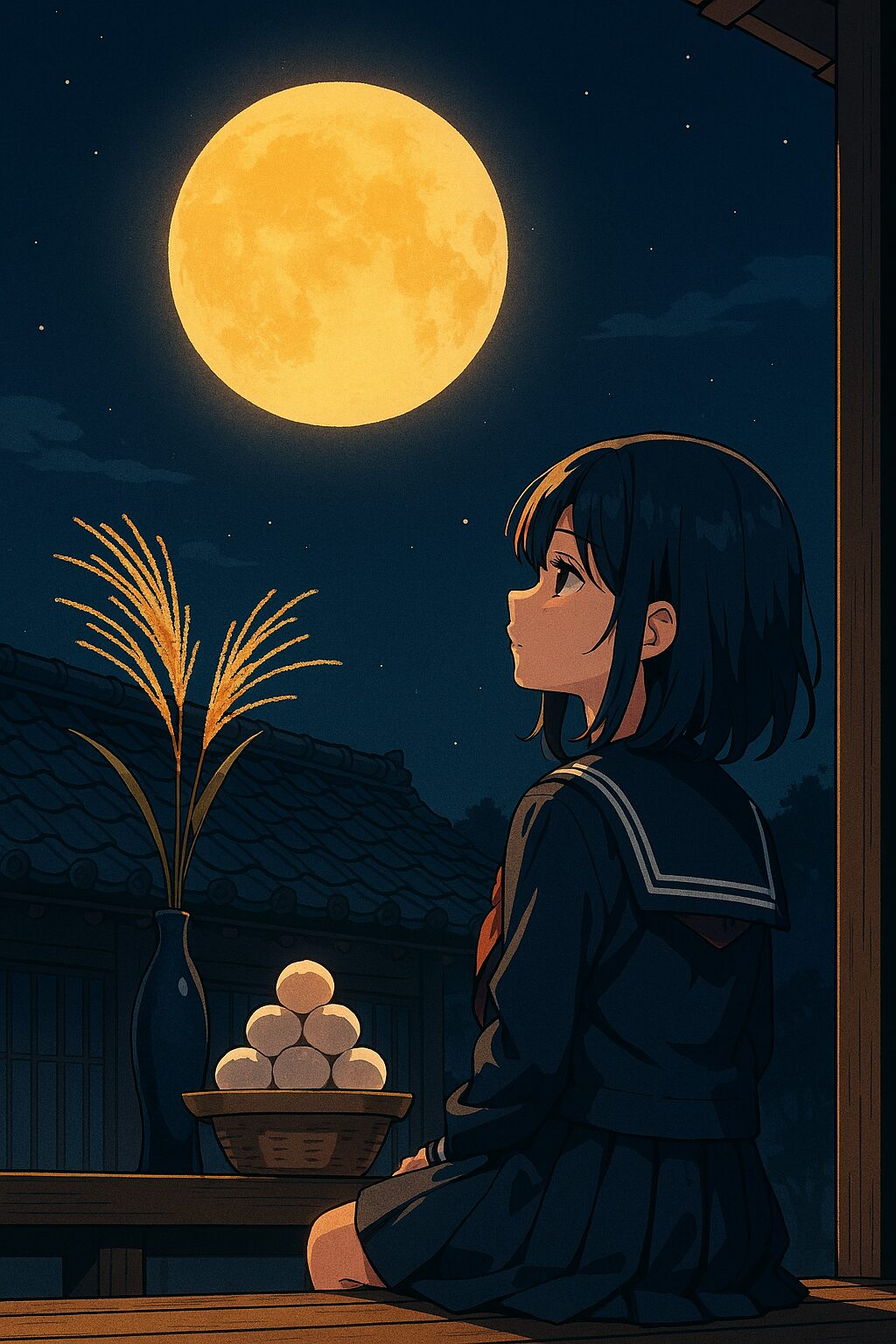① Keyword Introduction: October 6, 2025, Tsukimi (Mid-Autumn Moon Viewing)
October 6, 2025 marks a special night in Japan, the observance of Tsukimi (中秋の名月 – Chūshū no Meigetsu), which has been loved for centuries. This date corresponds to the 15th day of the 8th month in the old lunar calendar. Because the moon during this period was considered the most beautiful of the year, it evolved into the special custom of Moon Viewing (Tsukimi).
History: A Thousand Years of Lunar Love, from Heian Nobles to Commoners
The custom of Tsukimi arrived in Japan from China during the Nara period, flourishing particularly within the aristocratic culture of the Heian period. Nobles of the time did not look directly up at the moon; instead, they admired its reflection in the garden ponds or their sake cups, composing waka poems and hosting elegant banquets. This indirect method of appreciation embodies the delicate and profound aesthetic of Japan, which connects to “Wabi-Sabi.”
Over time, the custom spread to the Samurai class and then to the common people. In the Edo period, it incorporated elements of an agrarian ritual called “Imo Meigetsu (Taro Moon)”—a celebration to give thanks for the harvest—making it an event deeply rooted in daily life.
Culture: The Wishes Hidden in Dango and Susuki Grass
The three main offerings on this night are:
- Tsukimi Dango (Moon Viewing Dumplings): Shaped round like the full moon. The number offered is typically 15 (after the 15th day of the 8th lunar month) or 12 (after the number of months in a year). Made from rice flour, these dumplings symbolize gratitude for a good harvest and wishes for people’s health and happiness.
- Susuki (Pampas Grass): Used as a decoration. Because the heads of the Susuki resemble rice stalks, they are offered in place of the harvested rice to pray for a bountiful crop. It has also long been believed to possess the power to ward off evil.
- Satoimo (Taro): As Taro was harvested during the Edo period, the custom of offering taro and other harvested produce emerged. This is why Chūshū no Meigetsu is also called “Imo Meigetsu.”
These offerings are not merely food or decorations; they symbolize the Japanese **”heart”**—expressing **gratitude** for nature’s bounty, a **prayer** for the coming season, and wishes for **family health**.
② Decoding Japanese Culture: Tsukimi Reflects the Japanese View of Nature
Through the custom of Tsukimi, we can decode the Japanese spirit of emphasizing **harmony with nature** that lies deep within the culture.
1. The Aesthetic of the “Incomplete”
While Western culture often views the full moon as a symbol of completeness and power, in Japan, beauty is found in the process of the moon waxing and, eventually, **waning**. This connects to the concept of **”Mujōkan (Impermanence)”**—the aesthetic where the beauty of cherry blossoms is appreciated more at the moment they **fall** than at their peak. It is an expression of the Japanese aesthetic known as **”Mono no Aware”** (a sensitivity to things), influenced by **Buddhist thought**, which finds true beauty and emotion not in perfection but in things that change and eventually fade away.
2. “Emotional Projection” Etched in Poetry and Literature
In classical Japanese literature and waka poetry, the “Moon” functions not merely as a celestial body but as a **mirror reflecting human emotion**. Across works like the Manyōshū, Kokin Wakashū, and The Tale of Genji, the moon personifies complex human feelings such as **love, separation, nostalgia, and tranquility**. This is deeply tied to the **Shinto**-based view of nature, which does not separate humanity from nature but rather **projects** human emotions onto the natural world, seeking to live in unity with it. Admiring the moon was, in essence, an act of introspection.
3. Gratitude for Fertility and the Bonds of Community
The act of offering Tsukimi Dango and Susuki grass is not just about preserving tradition. It is a ritual in which the entire community shares the humble attitude that **”we are sustained by the blessings of nature”** and expresses **gratitude to the gods and spirits** who provided the harvest. Through this shared ritual, people reaffirmed their connection and strengthened the **communal bonds** that supported their challenging agrarian society.
③ A Question for the Reader
On **October 6, 2025**, as you look up at the night sky and bathe in the same light admired by ancient nobles and farmers, what will you think?
In our modern lives, enveloped by the brilliant lights of the city, we rarely have the chance to be fully aware of a starry sky or a crystal-clear moon. However, Chūshū no Meigetsu offers us an opportunity to reawaken the **”sense of connection with nature”** that we ought to possess.
If you are in Japan, why not prepare some dango, decorate with Susuki, and quietly gaze at the moon? It will be a wonderful experience of sharing the **”same emotion”** with the Japanese people across thousands of years.
This night, what kind of “Japanese spirit” will you decode through the moon?
And if you were to pass this tradition on, what would be the first thing you would want to convey?
④ Useful External and Internal Links
【External Reference Links】
- National Astronomical Observatory of Japan (NAOJ) – About Mid-Autumn Moon: https://www.nao.ac.jp/astro/sky/2025/10.html (For 2025 astronomical info)
- Agency for Cultural Affairs – Japanese Annual Events: (General information on annual events. Search is recommended as the specific URL may change.)
【Internal Related Articles】
- [Japanese Traditional Events] February 3rd, Setsubun: The Culture of Japanese Exorcism in Bean Throwing
- [Japanese Culture and Spirit] What is “Wabi-Sabi”? A Thorough Explanation of Japan’s Unique Aesthetic
【2025年10月6日】満月が照らす日本の心:中秋の名月に秘められた歴史と文化
① キーワード紹介:2025年10月6日、中秋の名月
2025年10月6日は、日本で古くから愛され続けている特別な夜、中秋の名月(ちゅうしゅうのめいげつ)を迎えます。これは旧暦の8月15日にあたり、この時期の月が一年で最も美しいとされてきたことから、特別な月見(つきみ)の行事として親しまれてきました。
歴史:平安貴族から庶民へ、千年続く月への愛
中秋の名月の風習は、中国から奈良時代に伝わり、特に平安時代の貴族文化の中で花開きました。当時の貴族たちは、直接月を見上げるのではなく、庭園の池や杯に映る月を眺めて、和歌を詠んだり、優雅な宴を催したりしました。この間接的な鑑賞方法に、日本の「わび・さび」にも通じる繊細で奥ゆかしい美意識が息づいています。
その後、月見の風習は時代と共に武士、そして庶民へと広がり、江戸時代には収穫を感謝する「芋名月(いもめいげつ)」という農耕儀礼の要素が加わり、より生活に根ざした行事となりました。
文化:団子とススキに込める願い
この夜の代表的な供え物は、以下の三つです。
- 月見団子(つきみだんご): 満月になぞらえて丸く作られ、供える数は一般的に15個(旧暦8月15日にちなむ)や、12個(一年間の月の数)とされます。米の粉で作られる団子は、豊作への感謝と、人々の健康と幸福を願う象徴です。
- ススキ(薄): 供え物として飾られます。ススキの穂先が稲穂に似ていることから、稲の代わりに豊作を祈る意味合いや、古くから魔除けの力があると信じられてきました。
- 里芋(さといも): 江戸時代、芋の収穫期であったことから、里芋を中心とした収穫物を供える風習が生まれました。このため中秋の名月は「芋名月」とも呼ばれます。
これらの供え物は、単なる食べ物や飾りではなく、自然の恵みへの感謝、来るべき季節への祈り、そして家族の健康を願う日本人の「心」を象徴しているのです。
② 日本文化の読み解き:月見が映す日本人の自然観
中秋の名月という行事を通して、私たちは日本文化の深層にある自然との調和を重んじる精神を読み解くことができます。
1.「欠けているもの」への美意識
西洋文化では、満月は完全性や力強さの象徴として捉えられることが多いですが、日本では、月が満ちていく過程、そしてやがて欠けていく過程そのものに美を見出します。これは、桜が満開の時よりも散り際に美を見出す「無常観(むじょうかん)」に通じています。完璧ではなく、変化し、やがて消えゆくものの中にこそ、真の美しさや感動を見出す、仏教思想の影響を受けた日本の「もののあわれ」という美意識の表れです。
2.和歌と文学に刻まれた「感情移入」
「月」は、日本の古典文学や和歌において、単なる天体ではなく、感情を映す鏡として機能してきました。万葉集、古今和歌集、源氏物語など、あらゆる古典文学で月は愛、別れ、郷愁、静寂といった人間の複雑な感情を代弁しています。これは、人間と自然を分離せず、むしろ自然の中に自らの感情を投影し、一体となって生きようとする神道的な自然観とも深く結びついています。月を愛でることは、自らの内面を見つめ直す行為でもあったのです。
3.豊穣への感謝と共同体の絆
月見団子やススキを供える行為は、単なる伝統の継承に留まりません。それは、「自然の恵みによって生かされている」という謙虚な態度と、実りを与えてくれた神仏への感謝を共同体全体で共有する儀式です。この共通の儀礼を通じて、人々は繋がりを確認し、厳しい農耕社会を支える共同体の絆を強めてきたのです。
③ 読者への問いかけ
2025年10月6日、夜空を見上げ、遥か昔の貴族や農民が愛でたのと同じ光を浴びるとき、あなたは何を思うでしょうか?
現代の私たちの生活は、煌々とした街の光に包まれ、満天の星や冴えわたる月を意識することが少なくなりました。しかし、中秋の名月は、私たちが本来持っているはずの「自然と繋がる感覚」を呼び覚ます機会を与えてくれます。
もしあなたが日本にいるなら、団子を用意し、ススキを飾り、静かに月を眺めてみませんか。それは、数千年の時を超えて、日本の人々と「同じ感情」を共有する素晴らしい体験となるはずです。
この夜、あなたは月を通して、どんな「日本の心」を読み解きますか?
そして、もしあなたがこの伝統を誰かに伝えるとしたら、何を一番に伝えたいですか?
④ 参考になる外部リンク、内部リンク
【外部参考リンク】
- 国立天文台 – 中秋の名月について: https://www.nao.ac.jp/astro/sky/2025/10.html (2025年の天文情報確認用)
- 文化庁 – 日本の年中行事: (具体的なURLは変更の可能性があるため、検索推奨)



コメント